2008 Fish Owl Field Season
This field season is over. To learn how the 2008 winter field season progressed, read on or download the .pdf for later.
Fish Owl 2008 Field Journal
Jonathan Slaght
It’s February 10th and I am in Ternei; just back from the Faata River and pungent from three days of hiking river bottoms looking for owls and setting traps. I am presently heating the Goodrich banya and am looking forward to sweating out the grime.
I have been in Russia one week. Although I hope to leave Ternei for Amgu (5 hours north) as soon as possible, I am compelled to wait in Ternei until Tuesday (the 12th) to register in the county (as all foreigners must do).
Since I was last in Russia, members of the Blakiston’s Fish Owl Project and the Wildlife Conservation Society have collected location data on the four fish owls we tagged in the Tunsha River valley near Ternei in 2007. However, recent news has been concerning; the transmitters on most birds have been silent since December. As we already found one dead fish owl (untagged) near Ternei, a bird that was apparently shot for bait meat, I was concerned that perhaps some of our tagged birds had met the same senseless fate. I have used my extra time in Ternei to explore the Tunsha River valley and attempt to ascertain the current situation with our birds here.
Part of our team has already left for Amgu to find hunting areas of known pairs, where we will trap, and we will join them in a few days. With me now is Anatolii, a 56-year old capture specialist and a falconer who spent 24 years of his life in a Chukotka coal mine. I don’t know a whole lot about Chukotka (on the Bering Straight) or about coal mines (dark), but the combination of the two sounds horrible. Sergei Avdeyuk, with whom I worked closely last year, is in Olga (5 hours south of Ternei) determining how the two fish owl pairs we know of there are doing, and will join us in Ternei shortly.
The day after our arrival in Ternei, Anatolii and I quickly set up camp at Tolya’s hut on the Tunsha River. Anatolii caught some pigeons, and we set them as bait for a dho-gaza net on the Faata River on Friday evening. Although our VHF receivers were silent we could hear the Faata pair duetting as the sky darkened on Friday evening. This meant one of three things: that the transmitters on the Faata birds had failed, that the transmitters had fallen off, or that new birds had occupied the Faata territory. This question was quickly resolved as we re-captured the Faata male 15 minutes after dusk (Fig. 1).
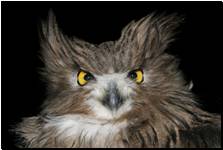
Figure 1. The Faata male, irritated to have fallen for
our tricks a second time.
We brought him back to Tolya’s hut to examine him and to see if we could determine why the transmitter was not working (Fig. 2). Tolya, if you did not read my field updates last year, is the friendly but crazy person who lives alone in the woods and is convinced that the nearby mountain is hollow, and there are a bunch of people with white robes in there (you just have to dig down 12 meters and you’ll find them). Tolya likes the fish owls and is generally happy to have our company. 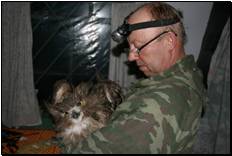
Figure 2. Anatolii looks for the transmitter while the Faata male tries to curse Tolya with his fish owl magic.
An examination of the Faata male showed that he was healthy (he weighed 3 kilograms; 250 grams more than last year); and a quick glance at his transmitter immediately showed why we were having trouble acquiring a signal: the antenna was gone.
How exactly it disappeared I don’t fully understand; perhaps the bird yanked on the antenna tip enough that it detached, or perhaps the construction was faulty. Either way, I can only assume the same thing has happened with the Faata female and the Serebryanka male (whose presence has been confirmed). I have not had time yet to determine where the Tunsha male is, but his transmitter is silent as well.
Soon we will head north to Amgu, but we will come back to the Tunsha valley in a few weeks where we will attempt to recapture tagged owls here and outfit them with new transmitters. It is a shame (an expensive one) that transmitters that should last three years are working less than one. The reason we are deploying expanding our study area to remote Amgu is that the lower human population density means that our birds are less likely to get shot there, and for study purposes live owls are far more useful than dead ones.
We left Ternei late on February 14th and slowly made our way to Amgu, stopping at known or suspected fish owl territories along the way to survey for species presence. Howling winds prevented us from getting any real work done, though, and we arrived in Amgu five hours later, around midnight.
Amgu, with a population of less than 1000, is a small, wind-swept cluster of wooden houses where the Amgu River swells to meet the Sea of Japan. Our contact here is Vova Volkov. Jovial and vulgar, Vova is a former professional hunter (under Soviet times) who now helps his wife operate a local store. He has known Sergei Avdeyuk for years, and has helped us off and on search for fish owls in the Amgu area.
The big news in Amgu these days is that Obmanov, the drunken prince of the local forestry fiefdom, has forbidden the only gas station within 200 km from selling gasoline to anyone other than forest service employees, for official forest service business. The reasoning is complicated; suffice to say that Obmanov is bent on power, fueled by vodka, and acutely paranoid; the unfortunate combination of these traits have caused problems for the citizens of Amgu for years. So, when we tried to fuel up on February 15th, we were denied service. Had Sergei not thought to bring along an extra 100 liters of gasoline, we might be stuck in Amgu for a long time, but his foresight allowed us to continue on to the Saiyon River (~20 km north of Amgu) to check on the pair there. Along the way we swerved to avoid a dog crossing the road; further scrutiny revealed that it was a frozen carcass that had simply been propped up along the roadside to alarm motorists such as ourselves (Fig. 3).
At Saiyon we met up with Shurik Popov and Kolya Gorlach; employees of the Amur-Ussuri Center for Avian Diversity who have been working with the Blakiston’s Fish Owl Project. Shurik works part time in the Institute of Biology and Soils museum preparing bird skins, but has had years of experience working with Sergei Surmach and looking for fish owls. Kolya drives and maintains the big GAZ-66 in which we will all sleep during our time in Amgu, and he acts as the crew cook as well. Shurik and Kolya had been sent ahead of us to scout out the fish owl scene in Amgu, and they squabble like an old married couple. Both are from a small farming village on the Khanka lowlands, a spacious region of wheat and soy; a world much different from the dark, mountainous forests of northern Primorye, which Kolya particularly appears to be mistrustful of.
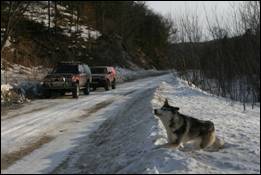
Figure 3. Someone propped this frozen dog carcass up next to the road to Saiyon.
Shurik is an expert tree climber and is adept at finding fish owl sign. He found a reliable fish owl hunting spot at Saiyon, and on the evening of February 15th I suited up in winter camouflage and created a little blind, and sat there until after dark when a fish owl flew noiselessly upriver and landed on a hunting perch some 20-25 m from me.
The bird sat there for a few minutes, then dropped into the shallow water of the Saiyon River below. A nearby fish owl whistled, probably the subadult from last year’s brood, and when the adult responded with a whistle, the second bird approached on foot with wings vigorously flapping to receive whatever prey had recently been caught. After three years studying these birds this was my first direct observation of foraging; highly entertaining. This hunting spot is right near the pair’s nest tree (Fig. 4). There is a German film crew planning to film the foraging behavior of fish owls at Saiyon, so for the time being we will not be capturing there.
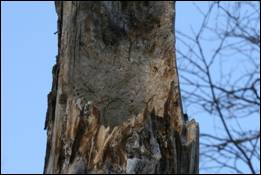
Figure 4. The Saiyon pair nest. As the female broods she chews at the bark inside the cavity, probably because she has nothing better to do.
On February 16th we arrived at the Leonovka River site, some 15 km west of Amgu. Obmanov had recently developed two hot springs for forest service use, and with his permission we set up camp there. A high-traffic fish owl foraging spot is within 100 m of the main hut, so the location for trapping was ideal. The cabin itself reeked of hangover; when we arrived the air was wet with vodka sweat and the wood stove still warm from whoever had been there the night before. We set a few traps and had the Leonovka female in hand by 8:30 pm that night (Fig. 5). Female fish owls are definitely more feisty than males; this one bit and clawed blood from three of the four people who handled her.
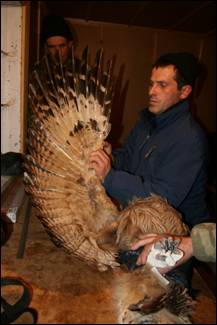
Figure 5. Shurik Popov assesses molt on the Leonovka female.
After a few dips in the hot springs (radon’s good for you, right?) we left the Leonovka for the Granatnaya River, where we were able to confirm pair presence (duet), locate a few hunting spots on the mostly-frozen Granatnaya, and found a nest tree all on February 17th.
On the 18th we set a few traps and ended up catching a female mallard in a mist net around 7:45 pm. She apparently made enough of a racket to pique the interest of the Granatnaya male, as he soon became entangled in the same mist net when he approached to investigate the noise. We took some measurements (Fig. 6). He was a big fellow, weighing in at 3.75 kg.
Like the Serebryanka male last year, the Granatnaya male was pretty dazzled by the capture experience, and it took him a minute to fly off upon release. Therefore, we lingered at the Granatnaya site until February 19th to confirm that the pair resumed normal duetting behavior.
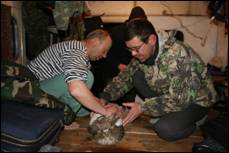
Figure 6. Tolya (left) and Sergei (right) take measurements of the Granatnaya male in the back of the GAZ-66.
We spent a few days on the Sherbatovka River looking for one of the two pairs there, but although we could find sign (tracks, feathers) the birds themselves were silent. We did however capture a Tengmalm’s (or Boreal) owl in one of our mist nets (Fig 7).
A fresh coating of snow revealed the presence of a tiger in the Sherbatovka basin; Sergei and I, who are accustomed to seeing tiger tracks, were amused by the irrational reactions from the flatlanders in the group. Tolya would not venture anywhere alone, and Kolya didn’t drink evening tea to avoid potentially fatal midnight bathroom runs.
On February 24th, eleven days after leaving Ternei, we split into two groups. After getting permission from Obmanov to re-fuel our truck (he called the gas station and told the woman there that ‘the orientologists’ were allowed 150 liters), Tolya and I headed south to Ternei to recapture some of the VHF-tagged owls there and find new owls. Sergei and Shurik remained behind in the Amgu area to confirm hunting areas of several fish owl pairs, and to assist the German documentary team film fish owl foraging behavior.
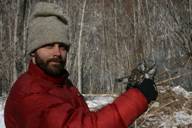
Figure 7. Jon with Tengmalm’s (Boreal) owl on the Sherbatovka River. These things are really cute. The owl injured himself during capture so we are holding onto him for a few days until he heals.
27 March 2008
The past month of fish owl work has been difficult; Tolya and I began searching the Tunsha and Serebryanka river valleys in late February with the simple goal of re-establishing contact with the four owls we tagged here last year that apparently now have broken transmitter antennae. We know at least one fish owl was killed in this area in autumn 2007, as we recovered a shot-ridden skull and both wings, and there were reports of a second dead fish owl as well (but we were not able to find that carcass). Who was shot? With no fresh snow and poorly-calling owls, it took us more than two weeks just to ascertain that all birds are apparently where they should be (pairs at Serebryanka, Tunsha, and Faata, and a single bird on Ivan-Ivanich). Who was killed then, remains a mystery. Perhaps an undetected bird, or perhaps one known from 2007 who has since been replaced on one of the known territories by a new individual? Aside from the Faata bird we recaptured in early February, the only transmitter we had heard at this point was from the Serebryanka male, and only from close proximity (~150m) around a well-used roost in a Korean pine and a few suspected nest trees in the heart of that territory.
In the middle of March the Amgu crew returned to Ternei en-route to their respective homes for a week-long break. We sat in the GAZ-66 drinking tea when Kolya and Tolya began discussing various ways to get a cat to eat an onion. “You take a boot liner and you stick an onion way down as far you can,” Kolya began, leaning forward with fist clenched to represent the onion. Then jam your cat in, head first, so his nose is right up against the onion, and twist on his tail. Really twist it. He’ll get so angry that he’ll eat the onion. He’ll eat the whole thing if you twist long enough.” Tolya responded that where he’s from people step on cat’s tails to get them to eat onions. Kolya said nothing but nodded, as if to acknowledge the validity of the tail-stomping method of prompting cats to eat onions, and I made a mental note to remember this conversation.
On March 18th Sergei and Shurik returned to Ternei and we set out for Serebryanka with the GAZ-66 for a recapture. I had been itching to show someone with adequate scampering skills a few trees I suspected as the Serebryanka nest, and luckily Shurik was up to the task. As potential nest trees were mostly giant cottonwoods that are impossible to free climb; Shurik selected thinner nearby trees to scale. After inching his way 14 meters towards the sky in his socks; Shurik was able to confirm that we had indeed found the Serebryanka nest tree, a broken-top depression 15 meters up a massive cottonwood
On March 20th one of our prey enclosures was visited (Fig. 8), and on March 21st we captured a fish owl. We were stunned to discover that this bird, a male based on the size of his cloacae, was not the same one we captured here last year (Fig. 9). Where then, was last year’s bird, the one we had thought was the Serebryanka male?
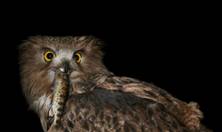
Figure 8. Reenactment of the Serebryanka male visiting our prey enclosure on March 20th.
On March 22nd I approached the Serebryanka nest tree and was able to determine that the male caught the night before was roosting in the nearby Korean pine, and that the transmitter from last year’s ‘male’ was coming squarely from the nest tree! Turns out we now have the pair, but since the newly-designated Serebryanka female is sitting on the nest we won’t be able to recapture her this winter. Later on March 22nd we focused our capture efforts on the Tunsha pair. The Tunsha river valley is a gnarly mash of mixed-old growth forest, brush, and thorns; the Tunsha pair was wise to nest in the heart of this mess. Approaching the nest is not easy, by no means silent, and pointy. The air in the forest was grey with smoke from spring fires when we arrived; the fields on the west side of the Tunsha river are charred from two days of persistent burns. The smoke and wafting ash made the forest seem even more foreboding, and my hope was that we could make short work of the birds here and move on to an easier, more accessible territory. Naturally the weather had other plans. We set two prey enclosures in known Tunsha hunting areas on March 22nd; on the second night one of the enclosures was visited and we set our traps the third day. However, an awful mixture of rain-sleet-snow-wind has swirled around Ternei for the past three days, and our efforts this far have not met with success. We have spent much of our time bolting from tents in the dead of night responding to trap transmitters triggered by empty, ice-covered, and sagging mist nets.
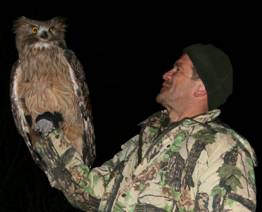
Figure 9. Sergei tells the real Serebryanka male a joke but the fish owl is puzzled by the punch line.
We have, however, been able to confirm nesting on the Tunsha territory as we found the female sitting firmly on the nest, and a second bird, presumably the Tunsha male (and the bird we tagged last year), flushed from a nearby roost as we approached. Interestingly, even at close distance I was not able to hear the signal from the Tunsha male’s transmitter, but I WAS able to hear the signal from the other (missing) Faata bird, who occupies the territory neighboring Tunsha to the north! My antenna was not directional so I could not tell for sure where the signal was coming from, but the next day Sergei returned and was able to say for sure that our Faata bird appears to have switched territories. I suspect that the Faata bird is sitting on the Tunsha nest, but want to wait for better weather before going in to find out; if we flush her from the nest in weather this foul the nest is in danger of failing. The degree of intrigue and bewilderment associated with studying a species as little-known as the Blakiston’s fish owl is a never-ending source of confusion and excitement.
We decided to wait out what I hope is that last day of this storm in Ternei, and have traps ready to go on Tunsha and on Faata to trap simultaneously. Time is running out for captures in Ternei; we need to head north to for more captures by early April, which leaves us only 3-5 days for remaining captures in this area. As it stands now, we have two fish owls here with fully-functional VHF transmitters, two fish owls with poorly-functional transmitters, one fish owl tagged in 2007 (the Tunsha male) still unaccounted for, and two fish owls tagged in Amgu. Hopefully the dataloggers up there are dutifully acquiring locations, and these birds will be easy to recapture for initial data download and battery recharge, and we can get back to Ternei for remaining VHF captures before I head back to Minnesota on April 25th.
10 April 2008
With regret, time constraints forced us to abandon VHF recapture attempts on the Tunsha and Faata territories near Ternei to refocus on the more pressing capture of fish owls in the Amgu area, some 200 km to the north. After nine days in Ternei the birds were simply not coming in to our traps, and we were running out of time to complete our work in Amgu. On our last trap night on the Faata we found a wet Collared scops owl in one of our nets; we brought him inside Tolya’s hut to dry. These are small, eared owls about the size of Screech owls, and with stunning blood-orange eyes. Unfortunately there was a massive miscommunication with Tolya, and when we returned from checking other traps and ready to take measurements and blood and photographs of the owl, it turned out that Tolya had released the little guy as soon as he had dried.
One small victory in the Tunsha territory was that we were able to confirm that the Faata female is now sitting on a single egg on the Tunsha nest (Fig. 10). How this came to be is a complete mystery. Is this common behavior among fish owls, or an anomaly? Hopefully our continued data collection with other tagged fish owls will help explain this unexpected, territory-switching behavior.
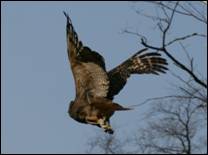
Figure 10. The Faata female flushes from the Tunsha nest (note her yellow leg band). Clearly I need to come up with a better naming system because this “territory-sex” business doesn’t seem to be working out.
I think it was Anton Chekov that said, “in Russia there are no roads, only directions in which one travels”. On March 31st Sergei (manning the ailing GAZ-66) and Shurik and I (in the Toyota HiLux) navigated the icy brown soup known as the road to Amgu; even in winter this road could barely maintain its composure, and any chance of getting to Amgu quickly and cleanly melted with the spring thaw. To make matters worse the GAZ-66 is in never-ending need of repair, despite Kolya’s assurances before our departure that it was in great working condition. Apparently Kolya resolves most vehicle maintenance issues with negligence and string: “Pull this rope if the engine gives you trouble”, he said before leaving for home in mid-March, pointing at a grease-stained cord that disappeared into a rusty hole in the dashboard. Vehicle repair is not Sergei’s job, but he has spent many hours poking at the GAZ-66 and driving around Ternei and Amgu looking for spare parts to remedy Kolya’s imperfect and dangerous improvisations (Fig. 11).
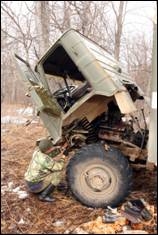
Figure 11. Sergei does a good job keeping the GAZ-66 running, but I think Kolya will likely get punched in the back of the head next time Sergei sees him.
When we arrived at the Leonovka territory and set up camp, the pair there greeted us with agitated vocalizations. Although the Leonovka pair did not visit our traps the first evening we set them, somehow a roe deer managed to wrap one-third of a mist net around his antlers, tethering him in place. This was a confusing and chaotic discovery in pre-dawn darkness, but one that solved our need for meat. The second night however we got her. The bird was soaked from the capture process so we held her overnight to dry, fed her four fish, and released her the next morning (Fig. 12)..
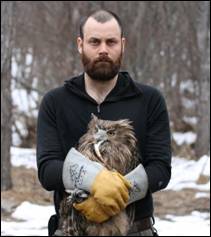
Figure 12. With the disinterested Leonovka female following capture on April 2nd, 2008.
Before breaking camp Sergei and Shurik headed out to the hot springs for a dip, but given what I have learned about radon since my last visit to the Leonovka hot springs (see above), I decided against floundering in the warm, radioactive waters this trip.
On April 3rd we relocated to the Granatnaya territory. Although Shurik had found a nest tree here in February, a visit to that nest showed that it had been cleaned but was not occupied. Fish owls are known to rotate between nest trees in different years, and given that the Granatnaya male’s cloaca at first capture strongly indicated breeding, we set out looking for another nest tree, which we found not more than 500 m from our camp, with the female sitting firmly in a broken-top cavity 12 m up a massive elm.
On April 5th, our second trap night, the male landed in one of our traps but did not stay long enough for us to grab him. He left behind some down feathers and the fish he had taken from the prey enclosure (Fig. 13).
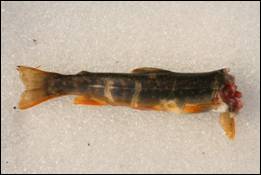
Figure 13. Dolly Varden trout freshly killed by the Granatnaya male and left behind after he tripped our trap and escaped. Note the two talon marks along the middle of the fish (they appear white), and the characteristically absent head: this is the first thing that fish owls chew off before consuming the rest of the fish elsewhere.
Sometime between April 5th and April 7th four things happened simultaneously: first, the warmer weather brought along rapid melting and notably higher water levels; second, frog populations responded almost immediately and they chorus raucously from ephemeral ponds; third, the fish disappeared from the Granatnayta River; and fourth, the Granatanaya male stopped hunting near our traps. It appears that a corner has turned where our winter trapping methods are no longer valid; the Granatnaya male could be hunting at any of the dozens of frog congregations in the two square kilometers around the nest tree. By April 10th our traps have been still for five days, and we have at best ten more days before we need to head south for me to wrap up loose ends and make my flight back to the United States. We are cutting it close.
19 April 2008
By April 10th our capture efforts on the Granatnaya continued without result. We began to rely almost exclusively on strategically-placed mist nets for capture, and it seemed that we were catching everything except fish owls. In one night alone we pulled four brown dippers, three Mandarin ducks, and a Solitary snipe from our nets (Fig. 14).
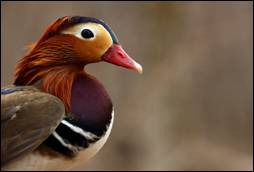
Figure 14. One of the Mandarin ducks we caught instead of the Granatnaya male.
By April 11th Sergei and Shurik had run out of cigarettes, and the already-tense atmosphere instantly became more colorful with the addition of severe nicotine withdrawal. Shurik spent most of the morning swearing while rooting around in pockets and in drawers and under car seats for that single, precious, forgotten cigarette. Sergei handled his withdrawal with a little more dignity; he spent half the day sleeping and eating candy. A simple and short drive into Amgu would have resolved this crisis, but that would signal victory for the addiction which Sergei does not like to admit he has. Thus he sat with furrowed brow, scheming the best way to nonchalantly answer nicotine’s siren call.
Given continued failures to capture our target bird, we decided to bring some action into our lives by flushing the Granatanya female from the nest to see what she was sitting on. Since identifying the nest tree on April 3rd we had avoided that area entirely to reduce stress on the birds. I collected some pellets from nearby roosts (mostly fish and frog bones; only one of the seven pellets contained mammalian remains); by the time I looked up Shurik had already clamored halfway to the nest and the bird flushed. I managed to get a few photos, which I was reviewing when Shurik called down that the nest contained two eggs. The majority of nests we have found recently contained only one egg, so this was interesting news. Even more interesting was that my photos revealed the Granatnaya ‘male’, betrayed by his color and metal leg bands, flushing from the Granatnaya nest (Fig. 15).
Another fish owl nest, another mystery. It’s astounding how bad we are at sexing these things. Or perhaps male fish owls share incubation duty? Our sex determination was based entirely on Shurik’s examination of the bird’s cloaca, and he was stunned that what he fondled in February may belong to a female: “If that’s a female fish owl cloaca,” he said, “you’d be able to SEE the male’s hanging between his legs.”
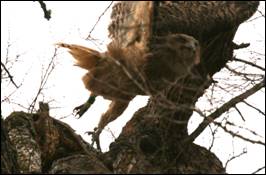
Figure 15. The Granatnaya ‘male’ flushes from the Granatnaya nest.
By early evening Sergei and Shurik had constructed a fairly complicated plan that rationalized use of the vehicle and would conveniently result in the acquisition of cigarettes: “Shurik wants to go to the Amgu River to GPS the locations of rocky shoals along the banks”, Sergei spoke with purpose, shrouding the plan with a veil of legitimacy. “We can compare these over time to see how the river is shifting. I will drive him to the river, and while out will also go to the store.” Masterful.
Given the confusing revelation at the Granatnaya nest, after eight days of fruitless capture attempts we decided to back off the Granatyana territory. The last thing we want to do is cause a nest to fail by recapturing and over-stressing a sitting female. My only regret is not checking the nest right when we got here in early April; this may have saved us a fair bit of time, effort, and frustration. Project members will return to Granatnaya at the end of May or in June for a recapture attempt then.
We quickly relocated to the Saiyon territory (15 km north of Amgu), and thankfully were able to catch the Saiyon male (presumably!) on our first capture night.
For most of this field season one of my more reliable nemeses has been our Globalstar satellite phone. Any attempt to make a call using this device is a mind-bendingly frustrating endeavor, usually requiring one to wander aimlessly for up to an hour under a clear sky, all the while waving a useless bit of blinking plastic in the air in a desperate search for Globalstar’s last remaining satellite. And from the frequency and quality of the signal, my guess is that this satellite is in low, unsteady orbit and rapidly dropping rusty parts.
When we first checked the Saiyon nest in March we found a cold and abandoned egg, which we marked and left in place. On April 14th we checked the Saiyon nest again and were pleased to find, next to the marked egg, a recently-hatched chick (Fig. 16).
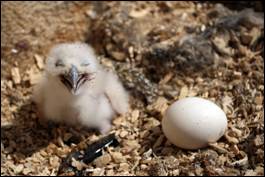
Figure 16. The Saiyon chick, begging for warmth and food, thinks I am able to meet these needs.
Given our unexpected delays at the Granatnaya territory, we did not have enough time to resume VHF capture attempts in Ternei. On April 15th the primary push of the 2008 capture season came to an end. I spent a few days in Ternei wrapping up loose ends before heading south to Vladivostok for my flight home. This gave me time to check on the Tunsha nest, where there is still one egg. I also spent some time with Basyanya, an orphaned and subsequently tamed raccoon dog (Fig. 17). Although raccoon dogs are the only members of the dog family that hibernate, apparently this urge can be resisted if supplied with a steady and rigorous diet of fresh fish. Thus, Basyanya spent the winter developing a prize-winning paunch and swagger not commonly seen among the species. In summary, this season there were six successful capture events of five fish owls (The Leonovka fish owl was caught twice), which means that there are presently five fish owls in our study population (the Serebryanka female and the Tunsha female have poorly-working transmitters, and the Tunsha male has yet to be re-sighted this year). Although there were serious setbacks this year, and we did not have as many VHF captures as I had hoped, the project is moving forward and making important advances
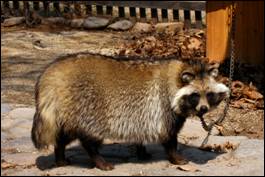
Figure 17. Raccoon dogs, aside from their propensity to carry the SARS virus, make great pets. Just take it easy with the sudden movements.
Funding for this field season has been provided by the U.S. Forest Service, the National Aviary, and the Minnesota Zoo. The Wildlife Conservation Society provided critical support, without which this project simply would not function.
Please note that some names in this journal were fictionalized.